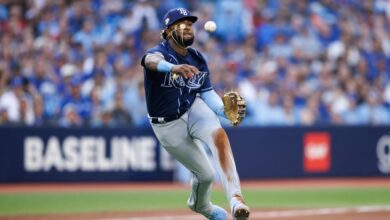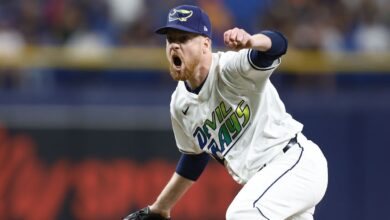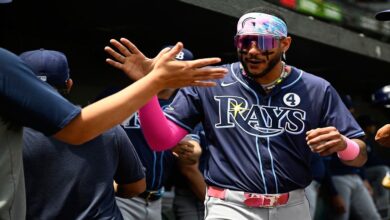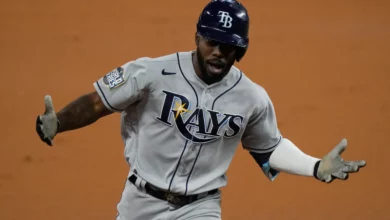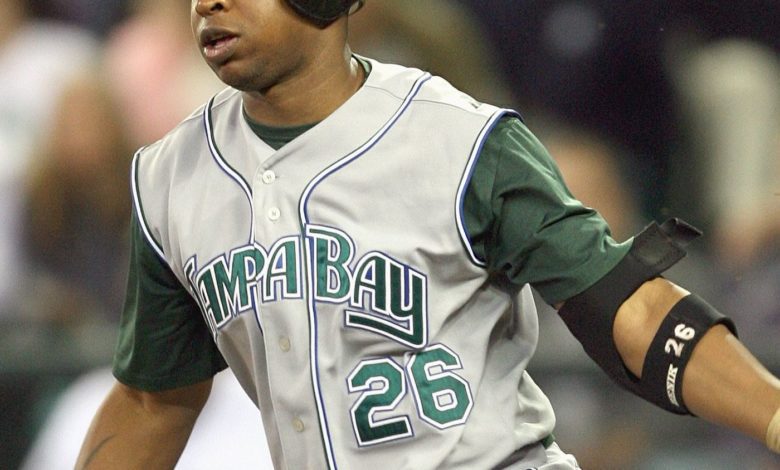
Do you know what the Ripple Effect is? Essentially, it states that one small act can cause a secondary act to happen, and that act can cause another one and so on and so forth. While the term “Ripple Effect” isn’t used in the baseball world often, the effects of it are frequent. The name Delmon Young might not ring a bell for every baseball fan in the world, but Tampa Bay Rays fans should be praising his name. Not for the production he brought, but for the lasting effects his departure brought.
Let’s start at the beginning. In 2003, the Rays had the first overall pick in the draft. With future all-stars Nick Markakis, Adam Jones, Rickie Weeks and others on the board, the Rays had a tough decision to make. They went with Young, and when he raked his way all the way up to the top of Baseball America’s top prospect list for 2006, he seemed to prove that Tampa had made the right decision.
Young played in 30 games for Tampa during that 2006 season, but played in all 162 in the following season. The results were so-so. Young showed promise, but also discouraging trends. Young batted .288 with 13 homers and 93 RBIs, but also had 127 strikeouts and only 26 walks. With another five years on his rookie contract, Young looked like a developing piece on a Rays team ready to compete, even though they had just finished last in the AL East. So it may have been surprising for some to see him traded to the Minnesota Twins along with infielder Brendan Harris and outfielder Jason Pridie for pitcher Matt Garza and infielder Jason Bartlett.
But at the same time, the Rays wanted to win now and already had several young promising outfielders like Melvin Upton Jr and Carl Crawford. They needed starting pitching and infield help. So when the deal was announced on November 28, 2007, one of the craziest trade trees ever was born.
For a team to go worst to first in any division is challenging, but in the then stacked AL East made it even harder. Tampa needed these new additions to contribute immediately, and that’s exactly what they did. Garza stepped in as the anchor of the rotation. He posted 11 wins and a 3.70 ERA in 30 starts in 2008, helping lead the Rays to the World Series. He would continue to provide top of the rotation results for Tampa’s remaining competitive window. Bartlett stepped in and became a superb middle infielder, hitting for average while providing excellent defense and creating havoc on the basepaths. Bartlett batted .288 and chipped in 61 steals during his three years in Tampa, establishing himself as a dependable middle infielder.
By the winter of 2010, both Garza and Bartlett had reached arbitration and were finally reaching sizable paydays. For the penny-pinching Rays, this meant it was time for some trades. Bartlett was shipped to San Diego for a four-player package of Cole Figueroa, Brandon Gomes, Adam Russell and Cesar Ramos. Bartlett immediately regressed in San Diego, and was out of the league entirely by 2015. Figueroa played in 23 games for Tampa, and didn’t make much of an impact. Gomes appeared in 173 games for the Rays over the next five years, posting a 4.20 ERA. Russell appeared in 36 games for Tampa over one season, posting a 3.03 ERA.
His lone season in Tampa would be his last. Ramos became a dependable bullpen piece for Tampa, appearing in 167 games over four seasons, posting a 3.66 ERA. Ramos was flipped to the Angels for minor leaguer Mark Sappington prior to the 2015 season, but he never developed, so the Bartlett side of the tree ends here.
Garza was a much more valuable trade chip at the time, and his return shows. Garza was flipped to the Chicago Cubs for a five-player package of Sam Fuld, Robinson Chirinos, Hak-Ju Lee, Brandon Guyer and Chris Archer. Fuld played in three seasons for Tampa in a fourth outfielder role and put up middling results. While Chirinos has developed into a solid power-hitting catcher, he only played in 20 games for Tampa before his contract was purchased by the Rangers. Lee made it on the top 100 prospects lists three years in a row, but never reached the majors. He left minor league baseball in 2016, and has since returned to competitive baseball in his native South Korea. Guyer played in five seasons for the Rays, becoming a starting outfielder in 2014, where he put up average numbers.
He was flipped to Cleveland for minor leaguers Nathan Lukes and Jhonleider Salinas in 2016. Lukes is still with Tampa but Salinas is currently in the Twins organization, so the tree has potential to continue. Even if the tree ended before Archer, it would be an incredible story for the Rays organization, but Archer’s inclusion shot it through the roof.
Archer made his debut in 2012, but broke out the following season. He became the new Garza for Tampa, posting solid ERA, WHIP and strikeout numbers, but could not get run support. He finished with a winning season just twice in his seven seasons with Tampa before his 2021 return. By 2016, his numbers started trending backwards. His ERA dipped into the low fours, and posted 19 losses that year. By 2018, he had rebounded slightly. His ERA was at a solid but unspectacular 4.31, and he had become a dependable back of the rotation starter.
By 2018’s trade deadline, an unexpected outlier had happened. The Pittsburgh Pirates, who were not expected to compete in a loaded NL Central that year, had gone on an incredible hot streak and put themselves squarely into buyer’s territory for the deadline. They felt they were one big piece away from playoff success, and zeroed in on Archer. He was still only 29 years old at the time, at the Pirates felt they could turn him back into the stud he was early in his major league career. Then on July 31, 2018, one of the biggest heists in baseball history was pulled off. The Rays traded Archer for a three-player package of Austin Meadows, Tyler Glasnow and a player to be named later.
Much like Bartlett, Archer regressed in his new home. He posted a 4.30 ERA in his remaining ten starts that season, and then a 5.19 ERA in 23 starts in 2019 before missing the entire 2020 season. He reached free agency afterwards and signed with the Rays again. An incredible disappointment for the Pirates even before seeing how the players they gave away panned out.
Meadows was one of Pittsburgh’s top prospects at the time, and has developed into a premier offensive threat for the Rays. He’s batted .259 with 59 homers and 183 RBIs in his 290 games with Tampa so far. Glasnow might have turned out even better. Another one of Pittsburgh’s top young players, he had already spent three seasons with the Pirates, posting a 3-11 record with a 5.79 ERA. The Rays might be the best organization in all of baseball at developing young pitching, and have certainly turned a corner with Glasnow. After posting a 4.20 ERA for Tampa in 11 starts after the trade in 2018, Glasnow posted a 1.78 ERA in 12 starts the following year, and was cruising to a 2.66 ERA in 14 starts this year before injury woes arose.
Tampa would have been thrilled with that trade even before the inclusion of Shane Baz as the player to be named later. Baz, the 12th overall selection in the 2017 draft, was yet another of Pittsburgh’s top prospects, and they somehow let him fall through the cracks as a player to be named later. Baz has done nothing but perform since he was traded. He started this year in Double-A, and after posting a 2.48 ERA in seven starts, he was bumped to Triple-A. Baz has responded in stride, sporting a 1.96 ERA in five starts at that level, and is a leading candidate to be a full time member of the Rays’ rotation by 2022.
To cap this off, we need to talk about WAR. WAR stands for Wins Above Replacement. If you took every single major league hitter in a single given year and averaged out their stats, you would get a base line. An offensive player’s WAR is determined by comparing their stats to that of the league average base line. The same thing applies to pitchers. Without getting too stat crazy, all you have to remember is the higher a player’s WAR is, the better.
To finally put this all into perspective, Delmon Young was worth roughly about 1.3 WAR before he was traded to the Twins. Since then, his entire trade tree has been worth roughly 51 WAR. That’s an absolutely astonishing amount of production for the Rays, and with Meadows, Glasnow and Baz all being young and controllable, there’s plenty more to come. The Rays are still a low-payroll team, so all three of Meadows, Glasnow and Baz are logical trade candidates when the time comes in a few years. At this rate, all three of them will be worth big trade packages, so it stands to reason the the Delmon Young trade tree will continue to reap benefits.
It’s not that farfetched to think the entire tree could be worth over 100 WAR by the time it’s said and done. Young was an above average player for his time, but generally not worth the first overall pick. Most teams would like a redo if they had one in that position, but the Rays might just do it again if they could.


